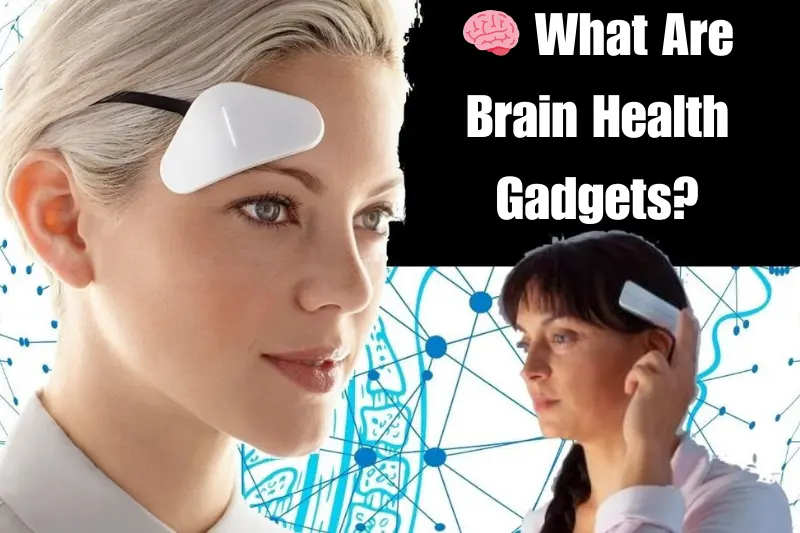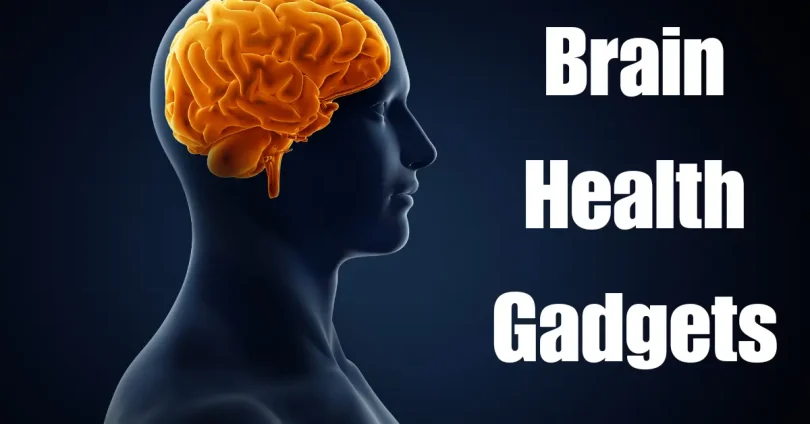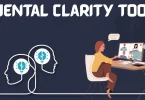In the digital age, where mental clarity, focus, and emotional balance are more important than ever, brain health gadgets have emerged as essential tools in the pursuit of optimal mental performance and well-being. These innovative devices use cutting-edge technologies to enhance cognitive functions, manage stress, improve sleep, and even support treatment for mental health conditions.
From students and professionals to senior citizens and athletes, people are increasingly turning to these gadgets to unlock their brain’s full potential. In this detailed article, we explore what brain health gadgets are, their benefits, top products in 2025, how they work, and what the future holds for cognitive technology.
🧠 What Are Brain Health Gadgets?

Brain health gadgets are electronic, often wearable devices designed to improve, monitor, or regulate cognitive functions. These tools are grounded in neuroscience and engineered to target specific brain activities or responses, enhancing overall mental well-being.
✅ These devices can:
- Stimulate brain activity to boost alertness and productivity.
- Help manage stress and anxiety using calming signals or guided meditations.
- Track brainwave patterns through EEG technology.
- Improve sleep and focus by regulating circadian rhythms or reducing brain overactivity.
- Provide neurofeedback to help users train their minds for better performance or recovery.
They leverage technologies such as:
- EEG (Electroencephalography)
- tDCS (Transcranial Direct Current Stimulation)
- Light therapy
- Vibration therapy
- AI-powered biofeedback systems
These gadgets translate real-time bio-signals into actionable insights, allowing users to adjust their behaviors, thoughts, or physical states accordingly.
You may also like to read this:
Powerful Strength And Performance Tools For Success
Body Optimization Tech For Better Health In 2025
Best Focus Apps For Better Time Management In 2025
Mindfulness Technology: Top Digital Tools For A Calmer Life
Powerful Productivity Tech To Enhance Efficiency In 2025
14 Best Mental Clarity Tools To Boost Focus & Productivity
🎯 Benefits of Brain Health Gadgets
Brain health gadgets aren’t just trendy accessories—they offer practical and scientifically backed benefits:
1. Enhanced Focus and Concentration
Neurostimulation devices help stimulate specific regions of the brain, allowing users to enter a “flow state” more quickly. This can be especially beneficial for students, gamers, and professionals looking to boost productivity.
2. Reduced Anxiety and Stress
Many gadgets include guided breathing exercises, calming music, or light therapy that lowers cortisol levels and activates the parasympathetic nervous system—your body’s natural relaxation response.
3. Improved Sleep Quality
Sleep-focused gadgets regulate melatonin production or slow brainwaves to help users fall asleep faster and stay asleep longer, which can dramatically improve mood and memory.
4. Memory Enhancement
Brain training apps and neurofeedback devices provide targeted exercises that stimulate the hippocampus, which is responsible for memory formation and retention.
5. Support for Mental Health Conditions
Some devices are FDA-approved and clinically validated for the treatment of mental health issues such as ADHD, depression, anxiety, and PTSD. These can be a powerful supplement—or even alternative—to traditional medication.
🔝 Top Brain Health Gadgets in 2025

Below are some of the leading devices revolutionizing cognitive wellness this year:
1. Muse S (Gen 2)
- Type: EEG Meditation Headband
- Key Features: Real-time brainwave tracking, heart rate and breath monitoring, sleep-tracking features, guided meditations.
- Best For: Mindfulness, meditation, sleep enhancement.
- How It Works: Muse uses EEG sensors to detect your brain’s electrical activity and gives you real-time feedback through audio cues, helping you stay focused or enter a relaxed state.
2. Apollo Neuro
- Type: Wearable Vibration Therapy Device
- Key Features: Personalized vibration routines, stress-relief programs, mobile app support.
- Best For: Anxiety management, improving focus, promoting deep sleep.
- How It Works: Worn on the wrist or ankle, Apollo Neuro uses silent vibrations to stimulate your parasympathetic nervous system, which promotes relaxation and balance.
3. Neuroon Open
- Type: Smart Sleep and Light Therapy Mask
- Key Features: Light therapy, sleep analytics, meditation assistant, mobile app.
- Best For: Jet lag recovery, regulating circadian rhythms, improving sleep.
- How It Works: The mask emits light pulses to influence your brain’s sleep-wake cycle while tracking your sleep quality with integrated sensors.
4. Flow Neuroscience Headset
- Type: Transcranial Direct Current Stimulation (tDCS) Device
- Key Features: Clinically approved for depression treatment, paired mobile app for therapy coaching.
- Best For: Depression relief, mood regulation, cognitive therapy.
- How It Works: Sends low-level electrical currents to targeted brain regions associated with mood regulation. This non-invasive stimulation promotes neural activity in underactive brain areas.
5. Cove
- Type: Wearable Stress Reduction Device
- Key Features: Worn behind the ears, sessions only require 20 minutes per day.
- Best For: Managing daily stress, improving resilience, enhancing sleep quality.
- How It Works: Cove gently stimulates skin nerves behind your ear to communicate with brain regions responsible for relaxation and calmness.
6. BrainTap
- Type: Audio-Visual Brain Entrainment Headset
- Key Features: Uses binaural beats, isochronic tones, and light pulses; comes with guided meditations.
- Best For: Deep meditation, brainwave synchronization, cognitive training.
- How It Works: Syncs your brainwaves with specific audio and visual cues to help you enter deeply relaxed or focused states—ideal for stress relief and mental clarity.
🧩 How to Choose the Right Brain Health Gadget
With so many options, selecting the right gadget depends on your goals and lifestyle. Here’s a quick guide:
| Factor | What to Consider |
| Purpose | Are you looking to improve sleep, focus, memory, or manage anxiety? |
| Technology | Choose from EEG, tDCS, light therapy, vibration, or sound-based devices. |
| Comfort & Portability | Opt for lightweight, wireless devices if you travel frequently. |
| App Integration | Look for real-time feedback, goal setting, and cloud storage for progress. |
| Scientific Backing | Prioritize devices with clinical trials, FDA clearance, or peer-reviewed support. |
| Budget | Price ranges from $100 for basic biofeedback tools to $600+ for full-featured neurostimulation systems. |
🔬 The Science Behind Brain Health Gadgets
These gadgets are built on the foundation of neuroplasticity—the brain’s natural ability to reorganize itself by forming new neural connections in response to learning or stimulation.
Examples of technology in action:
- EEG Headsets: Track brainwaves (alpha, beta, theta, delta) and guide users into desired mental states.
- tDCS Devices: Modulate neuron excitability, often used in therapeutic environments for mood disorders.
- Biofeedback Tools: Teach users how to control involuntary functions like heart rate or respiration, often used for anxiety control.
- Light Therapy: Used to reset circadian rhythms and treat Seasonal Affective Disorder (SAD).
Numerous studies published in journals like Nature Neuroscience, Frontiers in Psychology, and The Lancet Psychiatry highlight the effectiveness of these tools in mental health, cognitive performance, and even neurorehabilitation.
⚠️ Challenges and Limitations
Despite their growing popularity, brain health gadgets do have limitations:
– User Consistency
Like exercise, results come from consistent use. Skipping sessions or improper use may yield little to no results.
– Cost
High-end gadgets can be expensive and may not be accessible for everyone.
– Individual Variability
Each brain is different; what works for one user may not work for another.
– Limited Regulation
Not all gadgets are thoroughly tested or FDA-approved. It’s crucial to research the product’s credibility and scientific backing.
🔮 Future of Brain Health Technology
By 2030, we expect brain health gadgets to become even more powerful and intelligent. Innovations may include:
- AI-Powered Personalization: Devices that automatically adapt to your brain’s activity in real time for optimized results.
- Brain-Computer Interfaces (BCIs): Hands-free control of devices using thought alone—already in early development stages by companies like Neuralink.
- AR/VR Integration: Immersive therapy environments for PTSD, phobias, and cognitive training.
- Wearable EEGs with 24/7 Monitoring: Giving users and clinicians constant insights into brain health.
- Institutional Adoption: Schools and corporations may use these tools to boost learning, creativity, and productivity.
🧠 Conclusion
Brain health gadgets are transforming the way we support mental well-being, focus, and emotional resilience. Using technologies like EEG, tDCS, light therapy, and AI-driven feedback, these tools offer real, science-backed benefits—from better sleep and reduced stress to enhanced cognitive performance and mental health support.
While they come with challenges like cost and individual variability, their potential is vast. As innovation continues, expect smarter, more personalized, and widely accessible devices that integrate seamlessly into daily life.
❓ FAQs
1. What are brain health gadgets?
Brain health gadgets are electronic devices, often wearable, that are designed to enhance cognitive function, reduce stress, improve sleep, and support mental wellness. They use technologies like EEG, tDCS, light therapy, and biofeedback to influence brain activity.
2. Are brain health gadgets safe to use?
Most devices are non-invasive and safe for general use. However, it’s important to choose gadgets that are clinically tested or FDA-approved, especially for mental health treatment. Always follow manufacturer guidelines and consult a professional if you have medical conditions.
3. Can these gadgets really improve memory or focus?
Yes, many brain health devices are backed by neuroscience research showing improvements in focus, memory, and attention when used consistently. Devices like EEG headbands and neurostimulation tools have shown measurable cognitive benefits.
Q4. Do I need a prescription to use brain health gadgets?
Most brain health gadgets are available over the counter and do not require a prescription. However, devices used for treating clinical conditions like depression or ADHD may benefit from guidance by a healthcare provider.
Q5. How long does it take to see results?
Results vary depending on the device, its purpose, and user consistency. Some people report feeling calmer or more focused after just one session, while others may need a few weeks of regular use to notice significant improvements.



